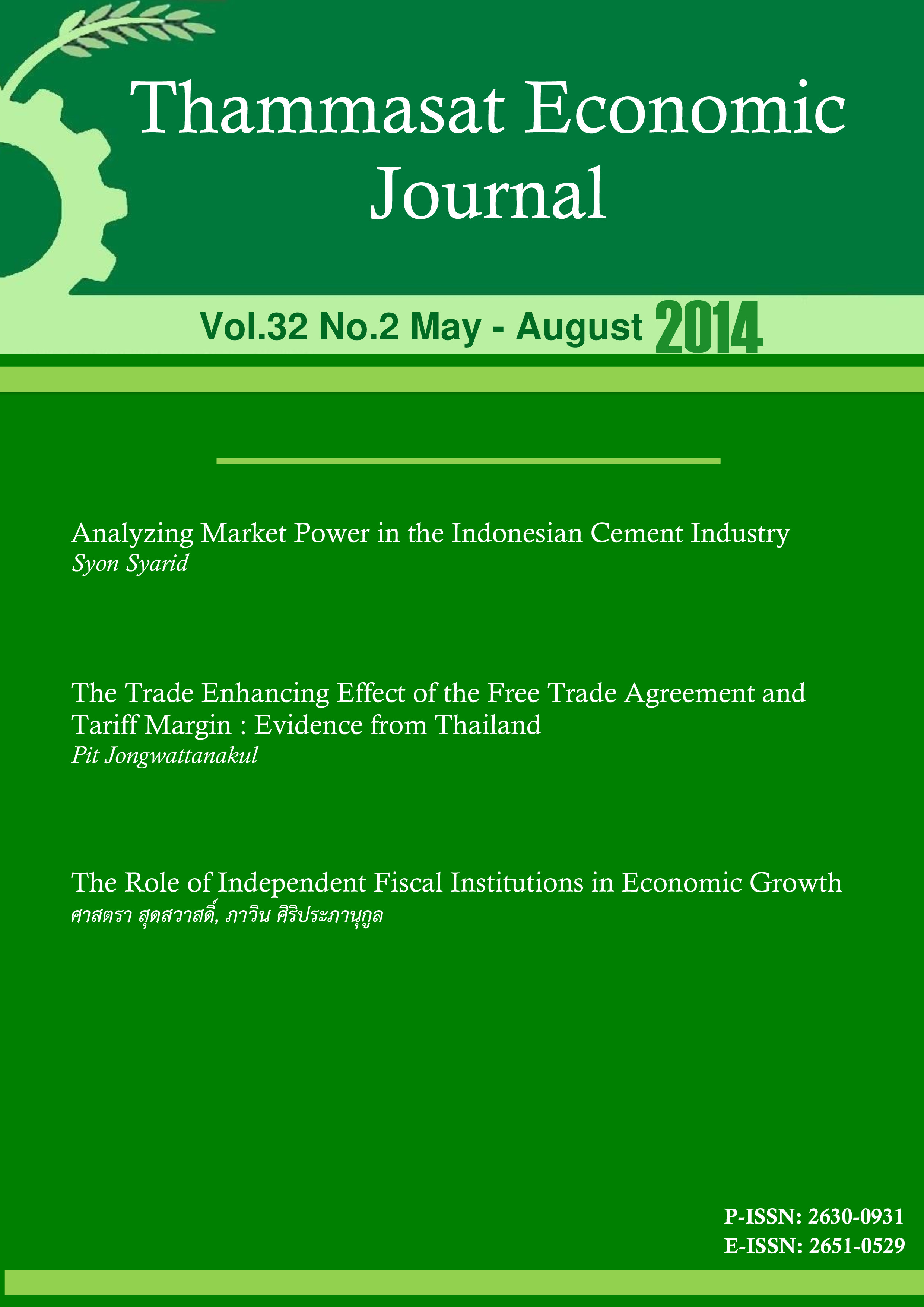The Trade Enhancing Effect of the Free Trade Agreement and Tariff Margin : Evidence from Thailand
Keywords:
Free Trade Agreement, Global Production Network, Gravity Equation, ThailandAbstract
This paper examines the trade enhancing effect from FTA, using Thailand as a case study. A gravity equation model, the popular trade model workhorse, is applied during the period between 1991 and 2010 with allowing export and import to perform differently to the preferential trade scheme. The novel feature of the paper is that actual tariff margin, the gap between MFN and preferential-FTA rates, is calculated to measure the effect from FTAs, instead of using zero-one dummy variable. In addition, the estimate of costs in complying rules of origin is included in the calculation. Also, Products are further disaggregated into manufacturing and machinery and transport equipment (SITC 7) to examine possible different impact of FTAs. Our key finding is how to measure FTA effect matters to the outcome. Zero-one dummy variable tends to overestimate trade enhancing effect. In addition, products under production network dominated by parts and components are less likely to utilize preferential trade scheme due to the already low tariff margin. Our result raises the policy awareness in maximizing a number of FTAs. Rather its trade enhancing effect depends on FTA partners and the nature of bilateral trade between them.
References
2.Feenstra, R., (2004). Advance International Trade: Theory and Evidence. Princeton, Princeton University Press.
3.Gilbert, J., Scollay, R., & Bora, B. (2004). New regional trading developments in the Asia-Pacific. in S. Yusuf, M. Altaf and K. Nabeshima (eds), Global Change and East Asian Policy Initiatives, New York: Oxford University Press.
4.Kohpaiboon, A. (2010). Product fragmentation phenomenon: trend, pattern and policy implication in Thai manufacturing. Bangkok: MisterKopy (Thailand) Co., Ltd.
5.Linnemann, H. (1966). An econometric study of international trade flows. North-Holland Publishing Company.
6.Nagai, F. (2002). Thailand's trade policy: WTO plus FTA. APEC Study Center, Institute of Developing Economies, JETRO.
7.Palley, T. I. (2003). Export-led growth: is there any evidence of crowding out?, in Arestis, P. et al. (eds), Globalization, Regionalism, and Economic Activity (pp. 175-797), Cheltenham, Edward Elgar (2003).
8.Phongpaichit, P., & Baker, C.J. (2004). Thaksin: The business of politics in Thailand. Nordic Institute of Asian Studies.
9.Tinbergen, J. (1962). Shaping the world economy: suggestions for an international economic policy. Twentieth Century Fund.
10.Anderson, J. E. (1979). A theoretical foundation for the gravity equation. The American Economic Review, 69(1), 106-116.
11.Anderson, J. E., & van Wincoop, E.(2003).Gravity with Gravitas: A Solution to the Border Puzzle.American Economic Review, 93(1), 170-192.
12.Athukorala, P. (2005). Product fragmentation and trade patterns in east asia. Asian Economic Papers, 4(3), 1-27.
13.Athukorala, P. (2012). Asian trade flows: Trends, patterns and prospects. Japan and the World Economy, 24(2), 150–162.
14.Athukorala, P., & Yamashita, N. (2006). Production fragmentation and trade integration: East Asia in a global context. The North American Journal of Economics and Finance, 17(3), 233-256.
15.Baltagi, B. H., Egger, P., & Pfaffermayr, M. (2003). A generalized design for bilateral trade flow models. Economics Letters, 80(3), 391-397.
16.Bergstrand, J. H. (1985). The gravity equation in international trade: Some microeconomic foundations and empirical evidence. The Review of Economics and Statistics, 67(3), 474-481.
17.Bergstrand, J. H. (1989). The generalized gravity equation, monopolistic competition, and the factor-proportions theory in international trade. The Review of Economics and Statistics, 71(1), 143-153.
18.Burger, M.J., Oort, F.G. van,& Linders, G.J.M. (2009). On the specification of the gravity model of trade: Zeros, excess zeros and zero-inflated estimation. Spatial Economic Analysis, 4(2), 167-190.
19.Cadot, O., de Melo, J. A.P., Estevadeordal, A., Suwa-Eisenmann, A., & Tumurchudur, B. (2002). Assessing the effect of NAFTA's rules of origin. Research Unit Working Papers 0306.
20.Chaney, T. (2008). Distorted gravity: The intensive and extensive margins of international trade. American Economic Review, 98(4), 1707-1721.
21.Chirathivat, S., & Mallikamas, S. (2004). Thailand's FTA strategy: Current development and future challenges. ASEAN Economic Bulletin 21(1), 37–53.
22.Disdier, A.C., & Head, K. (2008). The puzzling persistence of the distance effect on bilateral trade. The Review of Economics and Statistics, 90(1), 37-48.
23.Eaton, J., & Kortum, S. (2002). Technology, geography, and trade. Econometrica, 70(5), 1741-1779.
24.Elliott, R. J. R., & Ikemoto, K. (2004). AFTA and the Asian crisis: Help or hindrance to ASEAN intra-regional trade? Asian Economic Journal, 18(1), 1-23.
25.Endoh, M. (1999a). Trade creation and trade diversion in the EEC, the LAFTA and the CMEA: 1960-1994. Applied Economics, 31(2), 207-216.
26.Endoh, M. (1999b). The transition of postwar Asia-Pacific trade relations. Journal of Asian Economics, 10(4), 571-589.
27.Estevadeordal, A., & Suominen, K. (2005). Rules of origin in preferential trading arrangements: Is all well with the spaghetti bowl in the Americas? Economia 5(2), 63-103.
28.Falvey, R., & Reed, G. (2002). Rules of origin as commercial policy instruments. International Economic Review, 43(2), 393-407.
29.Fane, G. & Warr, P. (2008). Agricultural Protection In Indonesia, Bulletin of Indonesian Economic Studies, vol. 44(1), pages 133-150.
30.Huot, N., & Kakinaka, M. (2007). Trade structure and trade flows in Cambodia: A gravity model. ASEAN Economic Bulletin, 24(3), 305-319.
31.Jongwanich, J. (2010). Determinants of export performance in East and Southeast Asia. World Economy, 33(1), 20-41.
32.Kohpaiboon, A. (2006). Foreign direct investment and technology spillover: A cross-industry analysis of Thai manufacturing. World Development, 34(3), 541-556.
33.Kohpaiboon, A. (2009). Performance of AFTA and implication of trade policy in Thailand. Thailand Research Fund Full Report.
34.Kohpaiboon, A. (2010). Exporters' response to fta tariff preferences: Evidence from Thailand. RIETI Discussion Paper Series, 10-E-039.
35.Krugman, P. (1980). Scale economies, product differentiation, and the pattern of trade. The American Economic Review, 70(5), 950-959.
36.Matyas, L. (1997). Proper econometric specification of the gravity model. World Economy, 20(3), 363-368.
37.Sally, R. (2007). Thai trade policy: From non-discriminatory liberalisation to FTAs. World Economy, 30(10), 1594-1620.
38.Sarker, R., & Jayasinghe, S. (2007). Regional trade agreements and trade in agri-food products: evidence for the European Union from gravity modeling using disaggregated data. Agricultural Economics, 37(1), 93-104.
39.Silva, J. S.,& Tenreyro, S. (2006). The log of gravity. The Review of Economics and Statistics, 88(4), 641-658.










